Throughout the summer of 2016, NOAA's Office of National Marine Sanctuaries teamed up with the Ocean Exploration Trust to explore the marine ecosystems of the West Coast. Working aboard the E/V Nautilus and utilizing remotely operated vehicles (ROVs), scientists mapped and explored targets throughout the U.S. West Coast, from Canada to southern California, including five national marine sanctuaries.
NOAA Office of Ocean Exploration and Research provides support for the complementary ocean exploration program of the Nautilus, which operates under a similar paradigm as NOAA Ship Okeanos Explorer.
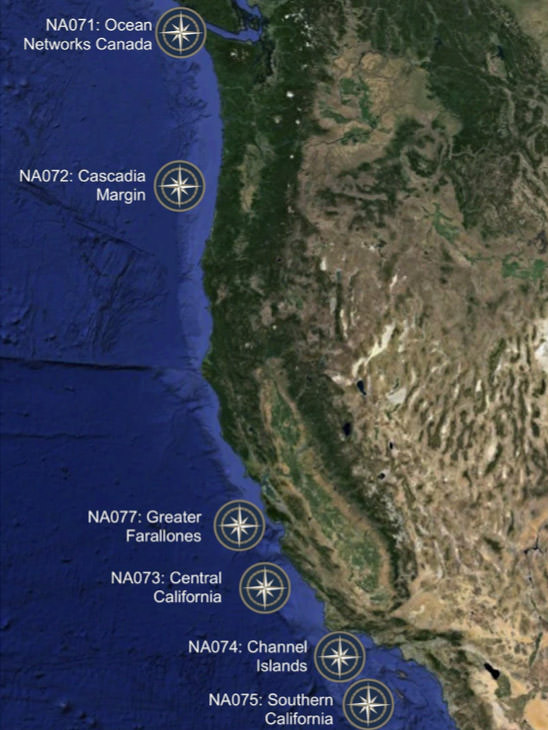
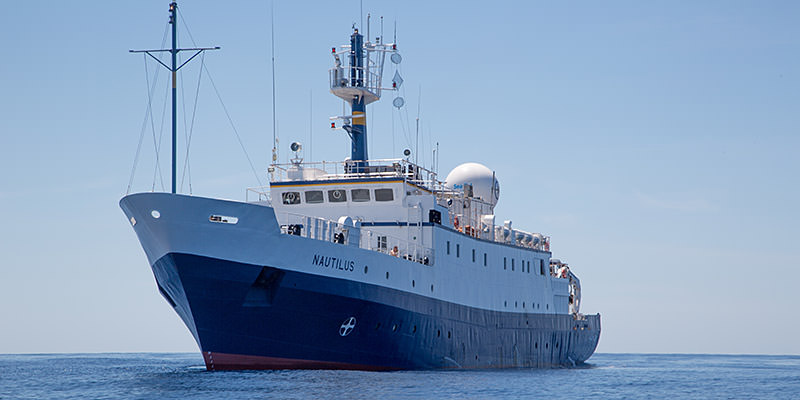
The E/V Nautilus is equipped with telepresence, which allowed scientists from around the world to participate and contribute to the success of this mission. Plus, telepresence brought national marine sanctuaries and ocean science to the classroom, as students across the country directly engaged with mission staff and operations.
Details and photos from the 2016 expedition can be found below, and the archive from the expedition can be seen at nautiluslive.org.
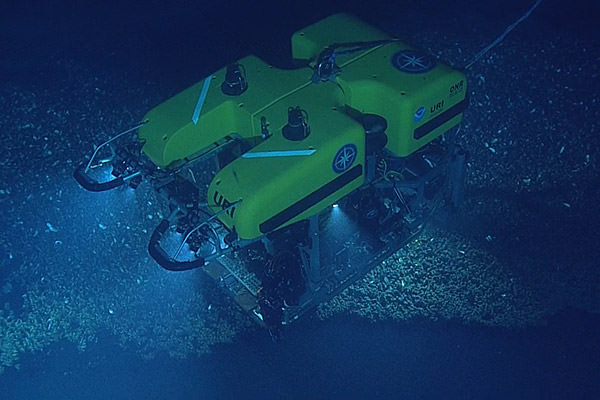
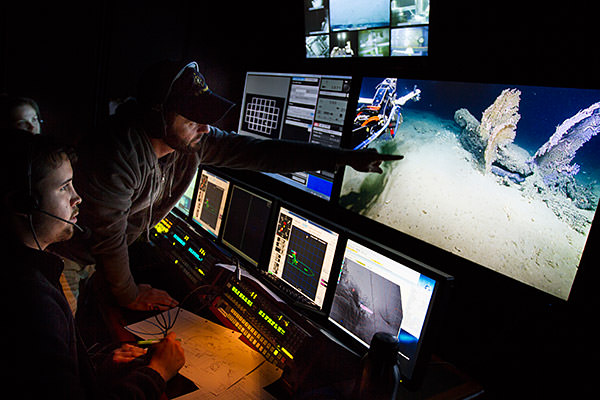
Dates: June 1-19, 2016
Lead Scientists: Dr. Robert Embley and Dr. Stephen Hammond, NOAA Pacific Marine Environmental Laboratory
Area of Exploration: Washington state to San Francisco, California, including Olympic Coast National Marine Sanctuary
On this expedition, the scientists on board Nautilus will use mapping tools to survey the extent of methane seeps along the Pacific Northwest coastline. Methane is a powerful greenhouse gas and an important commercial resource that fuels many elements of our lives on land. Scientists are beginning to understand the complex and varied ways methane fuels life beneath the sea as well. As habitats are identified, the ROVs will dive on these targets to investigate the structure and communities they support. A well-explored baseline understanding of these dynamic ecosystems will be essential for understanding changes as they occur. During this cruise, Nautilus will also explore the wreck of the World War II freighter SS Coast Trader, located just outside Olympic Coast National Marine Sanctuary in Canadian Waters. The ROVs will conduct the first visual survey of this cultural heritage site as well as assess its condition and remaining vessel stability.
Scientists also plan to explore for the first time (by deep submergence vehicle), the unique geological features that define the jagged rim of Quinault Canyon within Olympic Coast National Marine Sanctuary on the Washington continental slope. Recent sonar mapping shows rock ridges, relict Pleistocene sediments, and reflectance from non-geologic formations that may indicate rich habitats for coral and sponge communities. Live underwater video will provide the first glimpse of the unexplored Quinault Canyon.
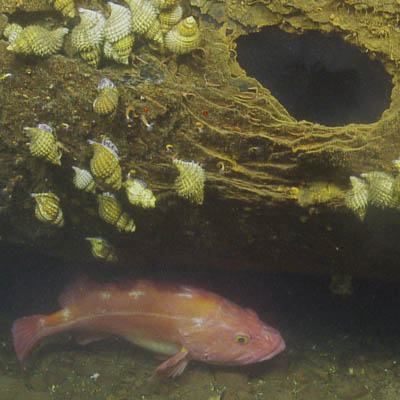
A fish hides in the wreck of the SS Coast Trader, an American merchant ship torpedoed by Japanese submarine I-26 on June 7th, 1942 in what is now Olympic Coast National Marine Sanctuary. Photo: OET/NOAA
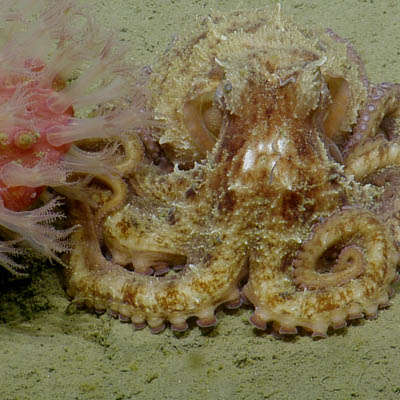
This octopus was spotted on an ROV dive near Olympic Coast National Marine Sanctuary. Photo: OET/NOAA
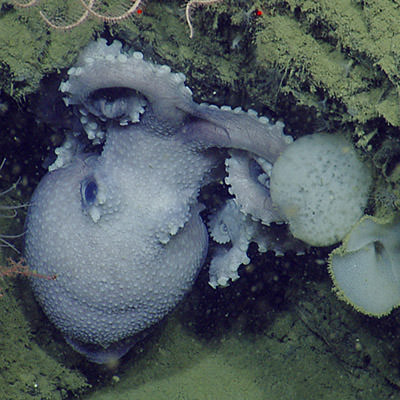
The Nautilus crew spotted this octopus while diving with an ROV in a canyon near Olympic Coast National Marine Sanctuary. Photo: OET/NOAA
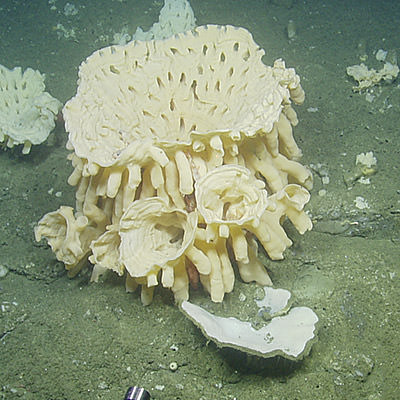
Glass sponges are found in the deep waters of submarine canyons like Gray's Canyon, near Olympic Coast National Marine Sanctuary. These sponges are named for their integration of silica into the porous body. In collaboration with experts on shore, Nautilus researchers collected substrate and sponge samples in Grays' Canyon to give clues about the glass sponge's growing habits, morphology and species variety. Photo: OET/NOAA
Dates: June 22-July 2, 2016
Lead Scientist: Dr. Peter Girguis, Harvard University
Area of Exploration: San Francisco to Santa Barbara Basin, including Cordell Bank, Monterey Bay and Channel Islands national marine sanctuaries
Beneath the waves, the California coastline shares the same rugged topography as its shoreline. Many submarine canyons cut across the continental slope, carrying shallow-water life and shorebased nutrients efficiently into the deep sea. A stark contrast from the steady, sloping topography of the continental shelf, deep sea canyons provide steep gradients that provide a unique way to study biological communities and geochemical processes.
Many California seafloor canyons have been sampled and explored in depths shallower than 500m but little exploration has occurred deeper. Nautilus will explore the hardground communities from Bodega Canyon in Cordell Bank National Marine Sanctuary south to Point Dume diving on canyons, rocky banks, terraces, and seamounts to survey the unique corals, sponges and sea life that inhabit these zones.
An component of this expedition will be to explore oxygen minimum zones along the Santa Barbara Basin and Channel Islands coastlines within Channel Islands National Marine Sanctuary. These naturally hypoxic basins are home to significantly fewer infaunal organisms who normally drive sediment recycling. Exploring areas like these offers a unique opportunity to study paleoclimates at a high resolution by sampling lesser disturbed ocean sediments. Organisms adapted to these ecosystems are of special interest due to their success living in more acidic and less oxygenated water.
This expedition will also include dives on Davidson Seamount in Monterey Bay National Marine Sanctuary, which is known to host coral and sponge communities.

July 13, 2016 - Santa Barbara, CA
Lobero Theater; 7:00 pm
Free Admission ~ Reserve a seat at eventbrite.com
Dr. Robert Ballard, world-famous explorer, President of the Ocean Exploration Trust, scientist and UCSB alumnus, will talk about the future of ocean discovery and the current expedition of theExploration Vessel Nautilus in the Channel Islands National Marine Sanctuary. Dr. Ballard will be joined by a panel of local students who will share their experiences aboard the Nautilus and participate in a Q and A.
July 16, 2016 - Santa Barbara, CA
Santa Barbara Museum of Natural History; 11:00 am - 12:00 pm
Join Channel Islands National Marine Sanctuary for a live chat with scientists and educators on board the Exploration VesselNautilus as they use an ROV to bring mysteries of the deep sea to you. http://www.sbnature.org/education/911.html
July 16, 2016 - Santa Barbara, CA
Santa Barbara Museum of Natural History; 11:00 am - 12:00 pm
Santa Barbara Maritime Museum; 1:00pm - 2:00 pm
Join Channel Islands National Marine Sanctuary for a live chat with scientists and educators on board the Exploration VesselNautilus as they use an ROV to bring mysteries of the deep sea to you.
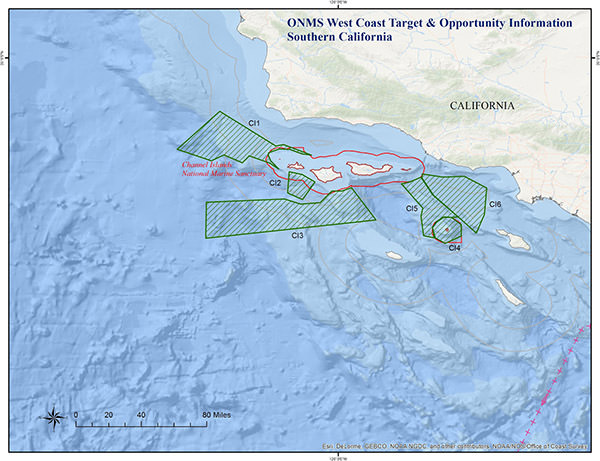
Dates: July 4-20, 2016
Lead Scientists: Chris Caldow and Julie Bursek, Channel Islands National Marine Sanctuary
Area of Exploration: Northern Channel Islands region, including Channel Islands National Marine Sanctuary
Channel Islands National Marine Sanctuary, located off the coast of Santa Barbara and Ventura counties in California, contains remarkable biodiversity, productive ecosystems, sensitive species and habitats, and shipwrecks and many other maritime heritage artifacts.
Less than 50% of the seafloor within the sanctuary's boundaries been mapped by high-resolution sonar. Nautilus will use a high resolution mapping system to collect sonar bathymetry and sub-bottom profiling data to characterize the seafloor in these unmapped areas. Following mapping operations, Nautilus will utilize the ROVs to make observations, collect high-definition video imagery, collect biological and geological samples, and ground truth the newly collected multibeam data. These data will help the sanctuary better understand and protect seafloor habitats and species, as well as respond to emerging threats on deep habitats such as climate change and ocean acidification.
Nautilus will survey geological and geophysical aspects of the region; make new observations about the structure and nature of tectonic faults, ridges, seamounts, and basins; and potentially identify, characterize, and sample unmapped and unexplored features such as oxygen minimum zones, gas seeps, marine terraces, paleoshorelines, hardbottom habitats, and their associated benthic ecosystems.
Dates: July 24-August 12, 2016
Lead Scientist: Marie-Helene Cormier, University of Rhode Island
Area of Exploration: Santa Barbara to San Diego, potentially including Channel Islands National Marine Sanctuary
E/V Nautilus will explore some of the most tectonically active (as well as densely populated) areas offshore California. The team will investigate the Southern California Margin, a broad area that fits entirely within the US Exclusive Economic Zone but that still remains largely unexplored. The margin is a heavily trafficked area and has been investigated for over 50 years by the academic community, federal agencies, military, and petroleum and fisheries industries. However, high-resolution multibeam bathymetric coverage of the seafloor here remains less than 50% complete, leaving much to be discovered.
The California Borderland has an unusually rugged topography linked to the complex tectonic history of the West Coast of the United States and includes prominent faults which lie closer than the San Andreas Fault to important centers of urban population. As well as contributing to an improved understanding of the offshore extent of these local geohazards, this cruise will also explore important biological ecosystems that have been found where active fluid flow has been located along such fault systems.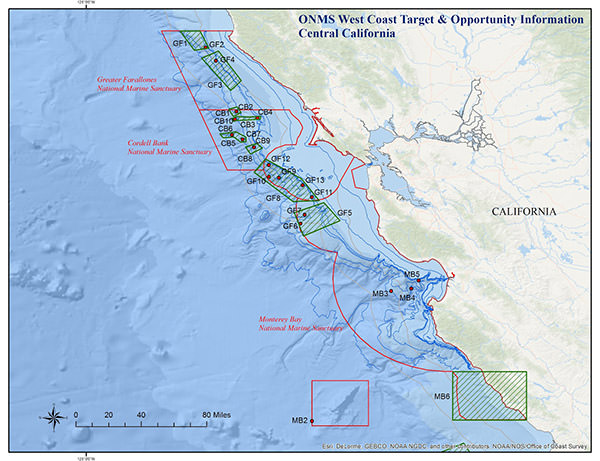
August 11, 2016 - San Francisco, CA
J. Porter Shaw Library, SF Maritime National Historical Park; 6:00 pm
Join James Delgado, Director of Maritime Heritage for NOAA's Office of National Marine Sanctuaries for a tour of the "Outside Ports" of the California lumber trade. Starting after the Gold Rush, these small anchorages, known as "dog hole ports," were the setting for coastal settlement, maritime trade and a number of shipwrecks. A planned detailed archaeological survey of several of these ports, both under the water and atop coastal bluffs, hopes to add more to our understanding of a trade now represented not only by these sites on the Sonoma and Mendocino coasts, but also by our own C.A. Thayer.
August 17, 2016 - San Francisco, CA
Aquarium of the Bay; 5:30 pm reception; 6:30 pm screening
Meet the Indiana Jones of the sea, and join maritime archaeologist, James Delgado as he takes us on a tour of some of the most amazing shipwrecks discovered over the last three years by NOAA. http://thebayinstitute.org/film-and-lecture-series
August 20, 2016 - Santa Barbara, CA
UC Santa Barbara Marine Science Auditorium; 11:00 am - 12:00 pm
Join Channel Islands National Marine Sanctuary for a live chat with scientists and educators on board the Exploration Vessel Nautilus as they use an ROV to bring mysteries of the deep sea to you.
August 23, 2016 - San Francisco, CA
Exploratorium; 1:00 - 2:00 pm
Join Greater Farallones National Marine Sanctuary for a live chat with scientists and educators on board the Exploration Vessel Nautilus as they use an ROV to explore the ocean floor off the central coast California. http://www.exploratorium.edu/visit/calendar/ship-chat-nautilus-8-23-2016
August 24, 2016
California Academy of Sciences; 11:50 am - 12:20 pm
Join Greater Farallones National Marine Sanctuary for a live chat with scientists and educators on board the Exploration Vessel Nautilus as they use an ROV to explore the ocean floor off the Farallon Islands of San Francisco.
August 25, 2016
California Academy of Sciences; 11:50 am - 12:20 pm
Join Greater Farallones National Marine Sanctuary for a live chat with scientists and educators on board the Exploration Vessel Nautilus as they use an ROV to explore the ocean floor off the Farallon Islands of San Francisco.
August 26, 2016 - San Francisco, CA
Exploratorium; 1:00 - 2:00 pm
Join Greater Farallones National Marine Sanctuary for a live chat with scientists and educators on board the Exploration Vessel Nautilus as they use an ROV to explore the ocean floor off the central coast California. http://www.exploratorium.edu/visit/calendar/ship-chat-nautilus-8-26-2016
August 26, 2016
California Academy of Sciences; 10:20 – 10:50 am
Join Greater Farallones National Marine Sanctuary for a live chat with scientists and educators on board the Exploration Vessel Nautilus as they use an ROV to explore the ocean floor off the Farallon Islands of San Francisco.
August 27, 2016
California Academy of Sciences; 10:20 – 10:50 am
Join Greater Farallones National Marine Sanctuary for a live chat with scientists and educators on board the Exploration Vessel Nautilus as they use an ROV to explore the ocean floor off the Farallon Islands of San Francisco.
August 27, 2016 - San Francisco, CA
Exploratorium; 1:00 - 2:00 pm
Join Greater Farallones National Marine Sanctuary for a live chat with scientists and educators on board the Exploration Vessel Nautilus as they use an ROV to explore the ocean floor off the central coast California. http://www.exploratorium.edu/visit/calendar/ship-chat-nautilus-8-27-2016
Dates: August 19-27, 2016
Lead Scientists: Jan Roletto, Greater Farallones National Marine Sanctuary; Dr. Chris Roman, University of Rhode Island; Dr. James Delgado, NOAA Office of National Marine Sanctuaries
Area of Exploration: Greater Farallones National Marine Sanctuary
Greater Farallones National Marine Sanctuary protects the wildlife and habitats of one of the most diverse and bountiful marine environments in the world. The region's unique combination of seafloor contours, ocean currents and wind patterns triggers an abundance of life in these waters. The sanctuary protects breeding and feeding grounds for at least 25 endangered and threatened species, 36 marine mammal species, over a quarter of a million breeding seabirds, and one of the most significant white shark populations on the planet.
Nautilus will study the cultural heritage and natural wildlife in the Greater Farallones National Marine Sanctuary. Nautilus will survey the USS Independence, a World War II era naval ship and former aircraft carrier, once used in the atomic tests at Bikini Atoll in the Pacific. Independence was scuttled offshore of San Francisco in 1951, rediscovered as the deepest shipwreck in the sanctuary, and acoustically mapped by NOAA in 2015 using autonomous underwater vehicles. Nautilus will conduct the first visual survey of Independence since its sinking as well as image the ship for photomosaic and microbathymetry data. Two other shipwrecks, the Ituna, a historic steam yacht from 1886, and the freighter Dorothy Wintermote, will also be explored. In addition to documenting and mapping these wrecks, the shipwrecks' roles as artificial marine habitat for fish and invertebrates will be assessed.
While in Greater Farallones National Marine Sanctuary, an additional goal of the cruise will be to characterize habitat of deep sea coral and sponges. These zones will be prioritized for future research as they serve as sentinel sites for ocean acidification monitoring and identification of impacts within an upwelling region. The expedition will collect biological samples of deep-sea corals and sponges and associated species for species identification and growth rate studies. This expedition will contribute to the baseline understanding of fish, deep-sea coral and rocky substrate communities within the sanctuary.